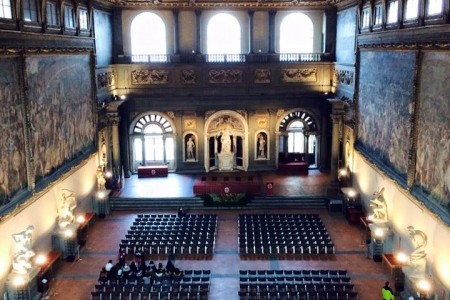Jackie Pollis
On February 12th the Gonzaga-in-Florence staff offered a rare tour of the secret passages within Florence’s Palazzo Vecchio to 13 lucky students. Palazzo Vecchio is the “medieval Town Hall” of Florence. It was the seat of government in the period of Cosimo de’ Medici’s rule. Duke Cosimo de’ Medici of the famous Medici family of Florence, moved his official seat from the Medici Palace on via Larga (near GIF’s campus!) to the Palazzo della Signoria in May 1540, signaling the security of Medici power in Florence. The name was officially changed after Cosimo moved once again to the Pitti Palace on the south side of the Arno River, renaming his former palace the Palazzo Vecchio, the “Old Palace”. Cosimo commissioned Giorgio Vasari to build an above-ground walkway, the Vasarian Corridor, from the “old palace”, through the Uffizi, over the Ponte Vecchio to the Palazzo Pitti.
We began the tour of the Secret Passages of Palazzo Vecchio by entering the building not from the main entrance but through a tiny door on the south side of the building, hidden from view unless you know where to look! We ascended the narrow passage of the Duke’s medieval stairway into the room that had been Cosimo de’ Medici’s bedroom. From it, there was a small hidden door that led to his “studiolo”, the tiny study where he hid many of his most prized possessions. The room was very small and surrounded on all sides by oval oil paintings. The images in the oil paintings corresponded to the treasures that were hidden in the small cupboard that lay behind each painting. However, upon opening one of the doors behind an oval painting, instead of a cupboard of shelves being revealed, a small hidden staircase was revealed! This small staircase led to another hidden room, the “Tesoretto” or Little Treasure where Cosimo would go to think or write or look out the tiny window. This little window sat immediately across from the governmental office building in the nearby Uffizi, so it was said that he could send secret messages to the people working in the government while in his small “tesoretto”.
The final stop was the Salone dei Cinquecento “the Hall of the 500”, the famous grand hall with art depicting the battles between Florence and Pisa as well as Florence and Siena. This hall was also where Gonzaga in Florence celebrated its 50th Anniversary reception two years ago. This grand hall was originally created in 1494 and at the time of creation, was slightly less grand.. In the late 16th century, Duke Cosimo de’ Medici commissioned Giorgio Vasari once again for construction. This time he wanted to enlarge the size of the Salone dei Cinquecento so that the ceiling was double the height. With a room of this magnitude without and pillars in the middle to hold it up, Vasari had to invent some very complicated scaffolding to hold up the enormous ceiling after raising it. Our tour group was able to go into the hidden room above the ceiling in order to see the scaffolding that Vasari built to hold up this huge and decorated ceiling. The mathematics and precision he used were incredible, and the structure is still holding strong to this day. The attached pictures should give a good idea of the magnitude of this room and the uniqueness of this great tour.






Leave a Reply